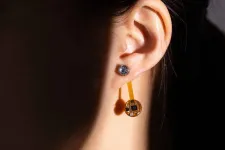(Press-News.org) About The Study: In patients with cryptogenic stroke and evidence of atrial cardiopathy without atrial fibrillation, oral anticoagulant therapy with apixaban did not significantly reduce recurrent stroke risk compared with aspirin in this randomized clinical trial that included 1,015 participants.
Authors: Hooman Kamel, M.D., of Weill Cornell Medicine in New York, is the corresponding author.
To access the embargoed study: Visit our For The Media website at this link https://media.jamanetwork.com/
(doi:10.1001/jama.2023.27188)
Editor’s Note: Please see the article for additional information, including other authors, author contributions and affiliations, conflict of interest and financial disclosures, and funding and support.
# # #
Media advisory: This study is being released to coincide with presentation at the International Stroke Conference 2024.
Embed this link to provide your readers free access to the full-text article This link will be live at the embargo time https://jamanetwork.com/journals/jama/fullarticle/10.1001/jama.2023.27188?guestAccessKey=8dbc1dfe-3156-41b0-bc51-06e41924a613&utm_source=For_The_Media&utm_medium=referral&utm_campaign=ftm_links&utm_content=tfl&utm_term=020724
END
Apixaban to prevent recurrence after cryptogenic stroke in patients with atrial cardiopathy
JAMA
2024-02-07
ELSE PRESS RELEASES FROM THIS DATE:
MD Anderson research highlights for February 7, 2024
2024-02-07
HOUSTON ― The University of Texas MD Anderson Cancer Center’s Research Highlights showcases the latest breakthroughs in cancer care, research and prevention. These advances are made possible through seamless collaboration between MD Anderson’s world-leading clinicians and scientists, bringing discoveries from the lab to the clinic and back.
Recent developments at MD Anderson include a combination treatment for patients with acute myeloid leukemia (AML), the discovery of a molecular driver in metastatic breast cancer, an oral combination therapy for high-risk myelodysplastic syndromes (MDS) and chronic myelomonocytic leukemia (CMML), a novel method to mechanically destroy ...
UW-developed smart earrings can monitor a person’s temperature
2024-02-07
Smart accessories are increasingly common. Rings and watches track vitals, while Ray-Bans now come with cameras and microphones. Wearable tech has even broached brooches. Yet certain accessories have yet to get the smart touch.
University of Washington researchers introduced the Thermal Earring, a wireless wearable that continuously monitors a user’s earlobe temperature. In a study of six users, the earring outperformed a smartwatch at sensing skin temperature during periods of rest. It also showed promise for monitoring signs of stress, eating, exercise and ovulation.
The smart earring prototype is about ...
Quantum simulation with ultracold fermions unveils pairing pseudogap
2024-02-07
A research team led by Professors PAN Jianwei, YAO Xingcan, and CHEN Yu'ao from the University of Science and Technology of China (USTC) of the Chinese Academy of Sciences, have for the first time observed and quantitatively characterized the many-body pairing pseudogap in unitary Fermi gases. This achievement, pursued by the ultracold atomic community for nearly two decades, resolves longstanding debates regarding the existence of a pairing pseudogap in these gases. It also supports ...
New research uncovers biological drivers of heart disease risk
2024-02-07
New gene mapping technique reveals how genetic alterations in cells lining blood vessels contribute to coronary artery disease, with implications for diagnostic and treatment strategies.
KEY TAKEAWAYS
Researchers from the Brigham, the Broad Institute, and Stanford Medicine studied how "deleting" individual genes associated with coronary artery disease (CAD) impacted the expression of all the other genes in a cell to better understand underlying biology of CAD.
The study focused on endothelial cells, which line blood vessels and are increasingly understood to influence CAD risk.
The researchers highlighted a previously unrecognized role for the TLNRD1 gene ...
Resting boosts performance of lithium metal batteries
2024-02-07
Next-generation electric vehicles could run on lithium metal batteries that go 500 to 700 miles on a single charge, twice the range of conventional lithium-ion batteries in EVs today.
But lithium metal technology has serious drawbacks: The battery rapidly loses its capacity to store energy after relatively few cycles of charging and discharging – highly impractical for drivers who expect rechargeable electric cars to operate for years.
Scientists have been testing a variety of new materials and techniques to improve the battery’s cycle life. Now, Stanford University researchers have discovered a low-cost solution: simply drain the battery and let it rest for several hours. ...
Machine learning models for predicting disability and pain following lumbar disc herniation surgery
2024-02-07
About The Study: The findings of this study including 22,000 surgical cases suggest that machine learning models can inform about individual prognosis and aid in surgical decision-making to ultimately reduce ineffective and costly spine care.
Authors: Bjørnar Berg, Ph.D., of Oslo Metropolitan University in Oslo, is the corresponding author.
To access the embargoed study: Visit our For The Media website at this link https://media.jamanetwork.com/
(doi:10.1001/jamanetworkopen.2023.55024)
Editor’s ...
Using cancer’s strength to fight against it
2024-02-07
Current immunotherapies work only against cancers of the blood and bone marrow
T cells engineered by Northwestern and UCSF were able to kill tumors derived from skin, lung and stomach in mice
Cell therapies can provide long-term immunity against cancer
CHICAGO --- Scientists at the UC San Francisco (UCSF) and Northwestern Medicine may have found a way around the limitations of engineered T cells by borrowing a few tricks from cancer itself.
By studying mutations in malignant T cells that cause lymphoma, they zeroed in on one that imparted ...
Trends in stroke thrombolysis care metrics and outcomes by race and ethnicity
2024-02-07
About The Study: In this study of more than 1 million patients with stroke, the Target: Stroke quality initiative was associated with improvement in thrombolysis frequency, timeliness, and outcomes for all racial and ethnic groups. However, disparities persisted, indicating a need for further interventions.
Authors: Gregg C. Fonarow, M.D., of the University of California, Los Angeles, is the corresponding author.
To access the embargoed study: Visit our For The Media website at this link ...
New direct links discovered between the brain and its surrounding environment
2024-02-07
In a recent study of the brain’s waste drainage system, researchers from Washington University in St. Louis, collaborating with investigators at the National Institute of Neurological Disorders and Stroke (NINDS), a part of the National Institute of Health (NIH), discovered a direct connection between the brain and its tough protective covering, the dura mater. These links may allow waste fluid to leave the brain while also exposing the brain to immune cells and other signals coming from the dura. This challenges the conventional wisdom which has suggested that the brain is cut off from its ...
Stress influences brain and psyche via immune system
2024-02-07
Chronic stress has far-reaching consequences for our bodies. For example, many stress-related psychiatric illnesses such as depression are associated with changes in the immune system. However, the underlying mechanisms of how these changes affect the brain are still largely unknown.
Enzyme from immune cells in the blood affects nerves in the brain
An international research team led by the University of Zurich (UZH), and the University Hospital of Psychiatry Zurich (PUK) and the Icahn School of Medicine at Mount Sinai, New York, has now uncovered a novel mechanism. “We were able to show that ...
LAST 30 PRESS RELEASES:
Researchers identify gene that calms the mind and improves attention in mice
Artificial metabolism turns waste CO2 into useful chemicals
Ancient sea anemone sheds light on animal cell type evolution
Begging gene leads to drone food
How climate policies that incentivize and penalize can drive the clean energy transition
Can community awareness campaigns in low-resource areas improve early diagnosis of colorectal cancer?
Stardust study resets how life’s atoms spread through space
Practical education: Clinical scenario-based program development
The impact of family dynamics on eating behaviour – how going home for Christmas can change how you eat
Tracing the quick synthesis of an industrially important catalyst
New software sheds light on cancer’s hidden genetic networks
UT Health San Antonio awarded $3 million in CPRIT grants to bolster cancer research and prevention efforts in South Texas
Third symposium spotlights global challenge of new contaminants in China’s fight against pollution
From straw to soil harmony: International team reveals how biochar supercharges carbon-smart farming
Myeloma: How AI is redrawing the map of cancer care
Manhattan E. Charurat, Ph.D., MHS invested as the Homer and Martha Gudelsky Distinguished Professor in Medicine at the University of Maryland School of Medicine
Insilico Medicine’s Pharma.AI Q4 Winter Launch Recap: Revolutionizing drug discovery with cutting-edge AI innovations, accelerating the path to pharmaceutical superintelligence
Nanoplastics have diet-dependent impacts on digestive system health
Brain neuron death occurs throughout life and increases with age, a natural human protein drug may halt neuron death in Alzheimer’s disease
SPIE and CLP announce the recipients of the 2025 Advanced Photonics Young Innovator Award
Lessons from the Caldor Fire’s Christmas Valley ‘Miracle’
Ant societies rose by trading individual protection for collective power
Research reveals how ancient viral DNA shapes early embryonic development
A molecular gatekeeper that controls protein synthesis
New ‘cloaking device’ concept to shield sensitive tech from magnetic fields
Researchers show impact of mountain building and climate change on alpine biodiversity
Study models the transition from Neanderthals to modern humans in Europe
University of Phoenix College of Doctoral Studies releases white paper on AI-driven skilling to reduce burnout and restore worker autonomy
AIs fail at the game of visual “telephone”
The levers for a sustainable food system
[Press-News.org] Apixaban to prevent recurrence after cryptogenic stroke in patients with atrial cardiopathyJAMA

